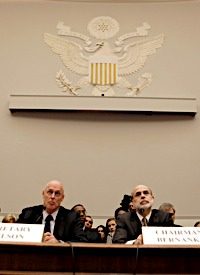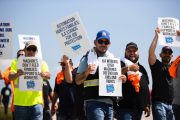
The two companies signed a tentative merger agreement September 15, 2008, but the agreement included a “Material Adverse Change” (MAC) clause that would allow Bank of America (BofA) to escape the merger if BofA financial officers found undisclosed financial information that would hurt BofA while looking at Merrill Lynch’s books. Bank of America shareholders approved the agreement with the MAC clause December 5, 2008. The final merger was to take place January 1, 2009.
But on December 14, BofA financial officers informed CEO Kenneth Lewis that Merrill Lynch’s quarterly losses would be $3 billion more than expected (the $9 billion in expected losses ended up being a $15 billion loss — a $6 billion increase over what stockholders expected and approved). Three days later Lewis informed U.S. Treasury Secretary Hank Paulson by phone that Bank of America planned to exit the merger using the MAC clause. Paulson urged Lewis to get on an airplane and visit his office.
Lewis met with Paulson and Bernanke December 21, where Lewis was told he would be replaced if BofA exercised the MAC clause. “I can’t recall if he said ‘we would remove the board and management if you called it’ or if he said ‘we would do it if you intended to,’” Lewis told Cuomo. Then Bank of America Chief Executive Officer Kenneth Lewis tried to “deescalate” the conflict by saying he’d talk to his board. Lewis also testified he was instructed not to reveal the staggering Merrill Lynch losses to his stockholders: “I was instructed that ‘We do not want a public disclosure,’” Lewis told Cuomo’s office. Lewis took it as a demand to defraud his stockholders, a demand that he and his board of directors complied with.
The BofA board met the next day to discuss the disastrous merger, and the minutes revealed: “The Treasury and Fed state strongly that were the Corporation [Bank of America] to invoke the material adverse change (“MAC”) clause in the merger agreement with Merrill Lynch and fail to close the transaction, the Treasury and Fed would remove the Board and Management of the Corporation.”
That decision by Lewis and his board led Bloomberg.com financial columnist Jonathan Weil to comment in a particularly insightful column: “As for Lewis and the rest of Bank of America’s board, it’s a foregone conclusion that their word is now mud. The more honorable and legally appropriate path for them would have been to resign rather than participate in the cover-up.”
But more than just honor was violated. The law was violated as well. According to bank fraud laws, Paulson, Bernanke, Lewis, and his board of directors committed bank fraud against their stockholders. The Justice Department’s Criminal Reference Manual says of the bank fraud law: “The elements of the offense of making a false statement are: (1) making a false statement or willfully overvaluing property or security knowing the same to be false, (2) for the purpose of influencing in any way the action, (3) of the enumerated agencies and organizations.”
Bank fraud laws are so severe that an actual loss of stock value needn’t be actualized in order for criminal bank fraud to take place, according to the Justice Department Criminal Reference Manual. “The mere probability of loss to the bank is sufficient to establish intent to injure, and neither a possibility of future benefit to the bank nor restitution is a defense.” Of course, Bank of America did experience a serious financial injury. The stock price tanked from about $30 per share in September down to $5 per share in March, an 87 percent loss of value, and the otherwise financially secure Bank of America needed billions in federal bailout money just to survive.
Senator Chris Dodd told CNN that hearings on Cuomo’s revelations may be warranted, though Weil noted, “Senate Banking Committee Chairman Christopher Dodd took V.I.P. loans from Countrywide Financial Corp., now a subsidiary of Bank of America.” So what are the chances that a serious investigation will take place?
Weil correctly points out: “Knowing what we know now, how could you ever trust anything Bernanke says again?” He also appropriately wonders openly whether current Treasury Secretary Timothy Geithner (then the New York Federal Reserve Bank chairman and number two man on the Fed’s Open Market Committee) was involved in the deal, or if he was somehow incompetently unaware of what was going on right under his nose. Either way, the government’s financial leadership in Washington right now is untrustworthy at best and felonious at worst.
In the mythology of the left, unregulated “free enterprise” as a financial system failed under the Bush administration. The Bank of America/Merrill Lynch fraud case authoritatively proves that mythology false. Laissez-faire free enterprise was pretty much the opposite of what happened on Wall Street during the financial boom and subsequent bust. The failure was caused by government, which in this case nearly bankrupted the largest bank in America when top government officials engaged in criminal fraud and leveled ugly political threats that — if they had been made by Mafia functionaries — would be prosecuted under racketeering laws.
Photo: AP Images



